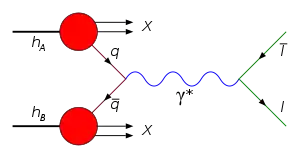Drell–Yan process
The Drell–Yan process occurs in high energy hadron–hadron scattering. It takes place when a quark of one hadron and an antiquark of another hadron annihilate, creating a virtual photon or Z boson which then decays into a pair of oppositely-charged leptons. Importantly, the energy of the colliding quark-antiquark pair can be almost entirely transformed into the mass of new particles. This process was first suggested by Sidney Drell and Tung-Mow Yan in 1970[1] to describe the production of lepton–antilepton pairs in high-energy hadron collisions. Experimentally, this process was first observed by J.H. Christenson et al.[2] in proton–uranium collisions at the Alternating Gradient Synchrotron.

Overview
The Drell–Yan process is studied both in fixed-target and collider experiments. It provides valuable information about the parton distribution functions (PDFs) which describe the way the momentum of an incoming high-energy nucleon is partitioned among its constituent partons. These PDFs are basic ingredients for calculating essentially all processes at hadron colliders. Although PDFs should be derivable in principle, current ignorance of some aspects of the strong force prevents this. Instead, the forms of the PDFs are deduced from experimental data.
Drell–Yan process and deep inelastic scattering
PDFs are determined using the world data from deep inelastic scattering, Drell–Yan process etc. The Drell–Yan process is closely related to the deep inelastic scattering; the Feynman diagram of the Drell–Yan process is obtained if the Feynman diagram of deep inelastic scattering is rotated by 90°. A time-like virtual photon or Z boson is produced in s-channel in the Drell–Yan process while a space-like virtual photon or Z boson is produced in t-channel in the deep inelastic scattering.
Sensitivity to light sea quark flavor asymmetry in the proton
It had been naively believed that the quark sea in the proton was formed by quantum chromodynamics (QCD) processes that did not discriminate between up and down quarks. However, results of deep inelastic scattering of high energy muons on a proton and a deuteron targets by CERN-NMC [3][4] showed that there are more d's than u's in the proton. The Gottfried sum measured by NMC was 0.235±0.026, which is significantly smaller than the expected value of 1/3. This means that d(x)-u(x) integrated over Bjorken x from 0 to 1.0 is 0.147±0.039, indicating a flavor asymmetry in the proton sea. Recent measurements using Drell–Yan scattering probed the flavor asymmetry of the proton.[5][6][7] To leading order in the strong interaction coupling constant, αs, the ratio of the Drell–Yan cross section from a proton beam on a deuterium target to a proton beam on a proton target is given by
where and are the anti-down and anti-up quark distributions in the proton sea and is the Bjorken- scaling variable (the momentum fraction of the target quark in the parton model).[5]
Z boson production
The production of Z bosons through the Drell–Yan process affords the opportunity to study the couplings of the Z boson to quarks. The main observable is the forward–backward asymmetry in the angular distribution of the two leptons in their center-of-mass frame.
If heavier neutral gauge bosons exist (see Z' boson), they might be discovered as a peak in the dilepton invariant mass spectrum in much the same way that the standard Z boson appears by virtue of the Drell–Yan process.
See also
References
-
Drell, S.D.; Yan, T.-M. (1970). "Massive Lepton-Pair Production in Hadron-Hadron Collisions at High Energies". Physical Review Letters. 25 (5): 316–320. Bibcode:1970PhRvL..25..316D. doi:10.1103/PhysRevLett.25.316. S2CID 16827178.
- And erratum in Drell, S. D.; Yan, T.-M. (1970). Physical Review Letters. 25 (13): 902. Bibcode:1970PhRvL..25..902D. doi:10.1103/PhysRevLett.25.902.2. OSTI 1444835.CS1 maint: untitled periodical (link)
- Christenson, J. H.; et al. (1970). "Observation of Massive Muon Pairs in Hadron Collisions" (PDF). Physical Review Letters. 25 (21): 1523–1526. Bibcode:1970PhRvL..25.1523C. doi:10.1103/PhysRevLett.25.1523.
- Amaudruz, P.; et al. (1991). "Gottfried sum from the ratio F2n/F2p" (PDF). Physical Review Letters. 66 (21): 2712–2715. doi:10.1103/PhysRevLett.66.2712. PMID 10043597.
- Arneodo, M.; et al. (1994). "Reevaluation of the Gottfried sum" (PDF). Physical Review D. 50 (1): R1–R3. Bibcode:1994PhRvD..50....1A. doi:10.1103/PhysRevD.50.R1. PMID 10017566.
- Hawker, E. A.; et al. (1998). "Measurement of the light anti-quark flavor asymmetry in the nucleon sea". Physical Review Letters. 80 (17): 3715–3718. arXiv:hep-ex/9803011. Bibcode:1998PhRvL..80.3715H. doi:10.1103/PhysRevLett.80.3715. S2CID 54921026.
- Towell, R. S.; et al. (2001). "Improved measurement of the d/u asymmetry in the nucleon sea". Physical Review D. 64 (5): 052002. arXiv:hep-ex/0103030. Bibcode:2001PhRvD..64e2002T. doi:10.1103/PhysRevD.64.052002. S2CID 118231497.
- Baldit, A.; et al. (1994). "Study of the isospin symmetry breaking in the light quark sea of the nucleon from the Drell-Yan process" (PDF). Physics Letters B. 332 (1–2): 244–250. Bibcode:1994PhLB..332..244B. doi:10.1016/0370-2693(94)90884-2.